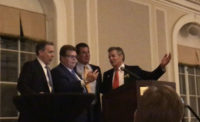
Tootsie Roll’s Melvin Gordon joins his wife, Ellen, as a Kettle Award recipient, making the two executives the first husband-and-wife team to earn that honor.
Tom Watson, 59, came within an 8-ft. putt of winning the British Open this summer. And even though his effort fell short several inches and just to the right, he won the admiration of millions of golf fans - and even more seniors - for re-establishing the fact that this world doesn’t just belong to the young.
Young-at-heart Melvin Gordon, chairman of Tootsie Roll Industries (TRI) and a spry 89, became the oldest recipient of Candy Industry’s Kettle Award on May 20, 2009. As exciting as the moment was that night, Gordon points out that he was even more thrilled when his wife, Ellen Gordon, president and chief operating officer of the company, captured the Kettle in 1985.
As the first husband-and-wife pair to individually receive such recognition, it’s not surprising to hear the two compliment and complement each other.
To this day, Melvin remains amazed at his wife’s ability to systemically focus and execute.
“Ellen has the ability to make a list of things to do, about 50 or 60 of them, and proceed to accomplish them all in a day, staying as long as she has to in order to take care of them in good fashion.”

Tootsie Rolls, essentially a blend of chocolate, caramel and fudge, are first cooked in one of six cookers (inset) before undergoing cooling and extruding. As the mass comes off the cooling drum, it’s conveyed to an extruder that produces 13-lb. chunks, which are then sized, cut and packaged. Prior to cartoning, individual Tootsie Rolls undergo visual inspection to ensure each piece is properly wrapped.
“He knows so much about business,” Ellen says. “I’m still learning from him every day.”
Obviously, the two make a great team. As Melvin describes it, “I’m Mr. Inside, and she’s Ms. Outside.”
The college football reference to Army All-American running backs Doc Blanchard and Glenn Davis reveals more than one might imagine. Blanchard, the “inside” bruiser, was as capable of running outside as speedster Davis, “Mr. Outside.” Both could score touchdowns with abandon and were incredible athletes.
Melvin and Ellen also are an incredible duo, scoring with strategic acquisitions and new product launches in an ongoing demonstration of uncanny business skills.
And although both have their respective responsibilities - “I’m more like the quarterback of the team, while Ellen oversees personnel, data processing and is chief of operations,” Melvin says - it’s clear the two can easily substitute for each other at a moment’s notice.
“I’ll pop into a meeting that Ellen is holding and see if there’s anything I can expand upon,” he says.
And as Ellen emphasizes, “We’ve worked together for so many years that either one of us can come in and take over a project for the other. We do a lot of handing off to each other.”
As expected, this confectionery All-Kettle backfield constantly remains in motion. It’s critical, emphasizes Ellen, because the industry is constantly changing.
“It’s not only true of our business, but all businesses,” she says. “There are changes in manufacturing, in marketing, in sales. There are new things to learn, to understand, to deal with, which is why we’re always rebuilding our manufacturing facilities, re-engineering our supply chain and developing new products.”
New product development remains one of the company’s growth strategies, along with product extensions and acquisitions.

Production of Dots gumdrops begins on a Bosch/Makat starch moulding line running at a rate of 30 moulds per minute. After depositing, the Dots then head to a curing room, where they remain overnight.
For example, Melvin’s forte involves operations. As he points out, his interest and experience in streamlining production goes back to when he was involved in the hosiery business.
“I have operations experience that transcends many generations, having grown up in production,” Melvin says. “This way I can help the people understand what we can make as well as how we can adapt existing machinery to make a new candy.”
Ellen, whose career path at TRI included new product development, investments and treasury as well as advertising, clearly understands the importance of producing a confection that addresses a particular consumer need, be it convenience, nostalgia or novelty.
Take the launch ofPop Dropslast year. Originally introduced in the 1970s when “roll” candies had a significant market niche, the bite-sized hard candies with aTootsie Rollcenter - essentiallyTootsie Roll Popswithout a stick - were withdrawn from the marketplace in the 1990s as a result of changing consumer buying habits.
Despite their absence from shelves,Pop Dropsretained a loyal core group of consumers who clamored for their return. Succumbing to popular demand, the company decided to reintroduce the candies last year, putting them into a foil pouch that, as the Gordons explain, meshed “well with current market formats and price points.”
Remaining sensitive to shifts on the playing field showcases another Gordon strength. Consider the growth of confections in the “theatre box” format. Here, the company has leveraged treasured brands such asJr. Mints,Dots,Charleston ChewandSugar Babies, and propelled them into the top ranking within the category.
As Melvin points out, the company prides itself on producing value confections. The theatre box format accents that competency and delivers to the consumer “a super value,” he says.
This year the company is expanding the power of its iconicAndesbrand to cookies,Andes Crème De MentheCookies, which should debut this fall.
But as Ellen points out, it’s not just about value, it’s also positioning.

Once demoulded, the Dots gumdrops are cleaned and inspected before they are transferred to packaging. There, a Triangle Packaging machine handles box forming, filling and sealing.
Many of TRI’s successful product launches have come from having leveraged the company’s stable of easily identifiable brands. Excluding the originalTootsie Roll, which was brought over by Austrian immigrant Leo Hirschfield in 1896 and became the first wrapped penny candy in the United States, andTootsie Pops, which were developed in-house in 1930, TRI’s remaining core brands have come through acquisitions.
The company acquiredDots, the fruit-flavored gumdrops, in 1972 from the Mason Div. of Candy Corp. of America. That successful purchase was followed by the Gordons buying Cella’s Chocolates in 1985, Charms in 1988, and theJr. Mints,Charleston Chew,Sugar BabiesandSugar Daddybrands from Warner-Lambert in 1993.
The new millennium ushered in another buying spree and the following acquisitions: Fluffy Stuff Cotton Candy, 2000; Andes Candies, 2000; and Concord Confections, 2004.
So what’s the Gordons’ secret to finding such successful pickups?
“We’re always looking at companies that would fit us, a sub-category that has an old franchised brand name, something we believe that we can build on,” says Melvin. “It also has to have a manufacturing facility that lends itself to automation where we can apply our have-how and reduce its costs and pump up profitability.”
As the Harvard-educated chairman points out, “Some of the companies we bought had issues with profitability. We felt we could turn them around with automation.”
Indeed, they did. Consequently, it’s no surprise that anyone who’s had the opportunity to stroll through one of the company’s seven manufacturing facilities can’t help but notice the level of technology and automation.
Last year, the company spent $34 million in capital expenditures, everything from processing and packaging machines to upgrades in infrastructure and software.
Take the company’s headquarters manufacturing facility in Chicago. The 2.2-million-sq.-ft. plant actually houses three processing operations (Tootsie Rolls,Dots and Tootsie Pops), warehousing and a distribution center. Originally built for the production of Wright Cyclone engines, which were used on B-25 bombers, the massive structure was designed so it could withstand a 500-lb. bomb.

A Goodman robotic pick ‘n place unit places the individual Dots boxes into a carton. Once transferred to shipping, a Fanuc robot then creates a pallet based on a customer’s order.
Since 1968, instead of Tuckers, suckers (as well as other confections) have rolled off the production line. (Each day, the company cranks out 65 millionTootsie Rolls, 23 millionDotsand 25 million lollipops.)
“In the late 1960s, before we moved to this facility in Chicago, we were producing between 150,000 and 200,000 lbs. a day,” says Melvin. “Once we started running production here, that grew to 250,000 lbs. a day. Today, we’re doing four to five time multiples of that.”
Efficient production, aided by technology and automation, has helped maintain the company’s strategic positioning - “a value house” delivering on quality.
It would be wrong, however, to suggest that all the company’s investments are focused on efficient cookers and servo motor drives. In March 2009, TRI opened a new 240,000-sq.-ft. distribution center in Hazelton, Pa., thereby facilitating delivery of its 36 brands of candies throughout the Northeast.
The company also completed work earlier this year on an automated sorting operation at its Chicago plant. Consisting of several miles of “smart” conveyors, UPC readers, pallet stackers and wrappers, the system sorts and prepares loads for the shipping dock’s 30 doors.
That investment coincides with the Gordons’ decision to implement a multimillion dollar supply chain software upgrade, a three-year process that’s now in its final phase.
“Our Enterprise Resource Planning [ERP] software will ensure that our customers receive exactly what they want, when they want it,” Ellen says.
That commitment reflects the changed retail landscape the company must navigate today. “In the past, 80% of our business was done in count goods,” Melvin says. “Today, the majority is in packaged goods.”

Tootsie Pop production begins by cooking the candy and depositing it on a cooling conveyor. Once sized and formed, the pops are cooled again and then feed into CFS Aquarius wrapping machines, which are capable of wrapping lollipops at 1,000 pieces/minute. The wrapped Tootsie Pops are then conveyed to the appropriate packaging machine, depending upon bag size.
“We usually double our sales during that quarter,” Melvin says. “It represents another operating quarter for us.”
But don’t expect any pronouncements from the Gordons about doubling growth within a certain time period.
“We have a long-term strategy,” Ellen says. “It’s not just about the next quarter or the quarter after. We want to ensure the integrity of the brands for many years. We certainly don’t want to sacrifice long-term growth for any immediate short-term profit-taking.”
Acknowledging that some Wall Street analysts don’t look favorably on such a close-to-the-vest approach - after all, TRI is a publicly traded company - the Gordon’s don’t back down from their measured business plan.
“Many analysts’ long-term horizons are much shorter than ours,” Ellen says. “We believe the future of our company lies in careful and managed growth.”
Part of that growth strategy entails targeted marketing, advertising and promotional campaigns. Although few consumers would fail to recognize TRI’s brands, reinforcement of the iconic candies in a fun and focused manner across all media remains a priority for the company. From sweepstakes to clever contests, the company looks to increase its activity via its Web site as well as other social networking media this year.
As for questions about succession, both Gordons believe they can easily tap into the talents of their four daughters.
“Our daughters are all professionals, several owning their own businesses,” Melvin responds. “They are all well-educated, having gone to either business, engineering or medical schools, all of them obtaining advanced degrees. Plus, two of our grandchildren have already worked here.”
In any case, neither Melvin nor Ellen are thinking of retirement anytime soon.
As Ellen points out, both she and Melvin come from families that never retire.
“We are used to working hard,” she says. “Melvin’s father continued working until he was 91, and my grandfather ‘till he was 95.”
Of course, when your executive team consists of Mr. Inside and Ms. Outside, the handoffs are just that much smoother.

At a Glance
Tootsie Roll Industries
Headquarters: Chicago
Sales: $492.1 million (2008)
Products: Chewable candies, lollipops, gumdrops, hard candies, chocolates, caramels, novelty candies, bubble gum and cotton candy.
Major Brands: Andes, Cella Cherries, Charms, Dots, Crows, Dubble Bubble, Fluffy Stuff, Junior Mints, Nik-L-Nip, Razzles, Sugar Babies, Sugar Daddy, Tootsie Pops, Blow Pops and Tootsie Roll.
Plants: 7 (Chicago; Covington, Tenn.; Cambridge, Mass.; Delevan, Wis.; Concord, Ontario, Canada (2); Mexico City, Mexico)
Management team: Melvin Gordon, chairman and ceo; Ellen Gordon, president and coo; Howard Ember, v.p. – finance and cfo; John Newlin, v.p. – manufacturing; Thomas Corr, v.p. – marketing & sales; John Majors, v.p. – physical distribution; Barry Bowen, treasurer & assistant secretary; and Richard Berezewski, controller.
Headquarters: Chicago
Sales: $492.1 million (2008)
Products: Chewable candies, lollipops, gumdrops, hard candies, chocolates, caramels, novelty candies, bubble gum and cotton candy.
Major Brands: Andes, Cella Cherries, Charms, Dots, Crows, Dubble Bubble, Fluffy Stuff, Junior Mints, Nik-L-Nip, Razzles, Sugar Babies, Sugar Daddy, Tootsie Pops, Blow Pops and Tootsie Roll.
Plants: 7 (Chicago; Covington, Tenn.; Cambridge, Mass.; Delevan, Wis.; Concord, Ontario, Canada (2); Mexico City, Mexico)
Management team: Melvin Gordon, chairman and ceo; Ellen Gordon, president and coo; Howard Ember, v.p. – finance and cfo; John Newlin, v.p. – manufacturing; Thomas Corr, v.p. – marketing & sales; John Majors, v.p. – physical distribution; Barry Bowen, treasurer & assistant secretary; and Richard Berezewski, controller.



